Cats may look graceful and mysterious, but their mating habits are anything but subtle. From loud calls and dramatic displays to the intricate timing of their heat cycles, reproduction in cats is a complex process.
For pet owners, understanding how and why cats mate isn’t just fascinating—it’s essential for making responsible choices about spaying, neutering, and preventing unwanted litters.
Deciding to Breed: The Responsible Approach
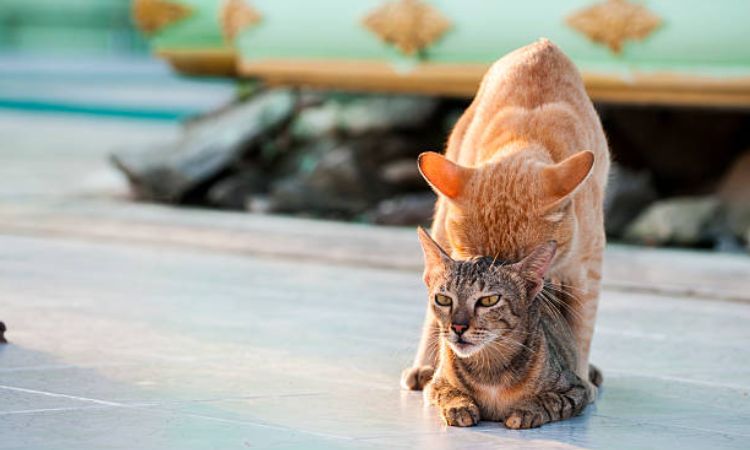
The Ethical Considerations of Breeding
Breeding cats is not a decision to take lightly. Pet overpopulation is still a serious issue, with many unwanted cats ending up in shelters every year. Even if you already have homes for the kittens, breeding adds to this challenge unless done responsibly.
It’s also important to understand the commitment involved. Caring for a pregnant queen, raising a litter, and ensuring proper veterinary care requires time, money, and emotional energy. Breeding should only be considered if you are fully prepared for the responsibility.
Health and Genetic Screening
Both the queen and the stud cat must be in excellent health before mating. A full veterinary checkup is essential to rule out infections and ensure they are fit to breed.
Responsible breeders also test for inherited conditions such as hypertrophic cardiomyopathy (HCM), polycystic kidney disease (PKD), and other breed-specific problems. Vaccinations should be current, and both cats should be protected against fleas, worms, and other parasites.
Skipping these steps risks passing on health issues to the kittens.
Finding a Mating Partner (Stud Cat)
The choice of stud cat is just as important as preparing the queen. Look for a male who is:
- Healthy and well-tempered
- From a sound pedigree with strong breeding history
- Backed by health certifications for genetic testing
A responsible breeder will always prioritize the cats’ welfare over profit and ensure the mating process is safe.
Spaying and Neutering: Why It’s Best for Most Cats
For most pet owners, spaying or neutering is the safest and most responsible choice. These procedures prevent unwanted litters and protect your cat’s health.
- Spayed females are less likely to develop mammary tumors or uterine disease.
- Neutered males are less likely to roam, fight, or spray urine to mark territory.
Most importantly, spaying and neutering help reduce the problem of cat overpopulation, while making your pet calmer, healthier, and happier.
The Mating Process
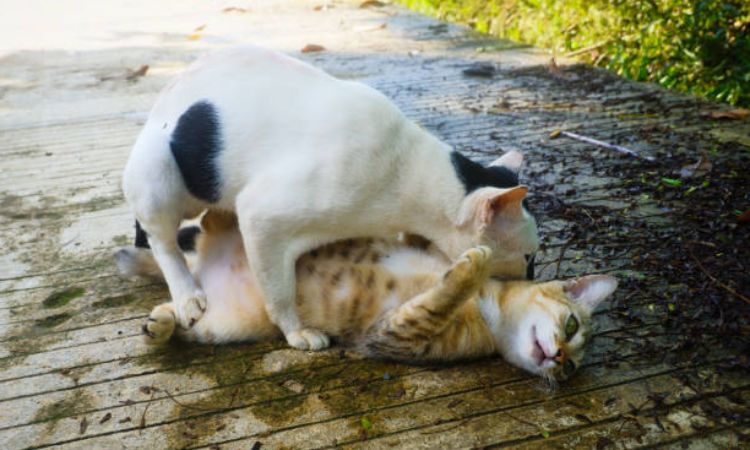
1. Preparing the Mating Environment
Before introducing the queen (female) and the tom (male), it’s crucial to set up a calm and safe environment:
- Choose a quiet, comfortable room with minimal disturbances, away from other pets or loud noises.
- Ensure the area is clean and secure, preventing the cats from escaping or injuring themselves.
- Provide familiar bedding and a few hiding spots so both cats feel safe and relaxed.
- Avoid forcing the cats together; allow the queen and tom to interact naturally once they are in the space.
A controlled environment reduces stress and makes the mating process smoother and safer for both cats.
2. The Mating Ritual and Courtship
Mating begins with courtship behaviors where the queen and tom get acquainted:
- The queen may exhibit behaviors such as rolling, rubbing against objects, vocalizing, or arching her back (lordosis), signaling her readiness.
- The tom shows interest by approaching, sniffing, and sometimes gently pawing or vocalizing to gain her attention.
- This initial interaction can last from several minutes to a few hours, allowing both cats to assess each other and ensure compatibility.
Understanding the Physical Act of Mating
Once the queen accepts the tom:
- The tom will bite the back of the queen’s neck to hold her in position.
- He mounts her and positions himself over her rear.
- Penetration is brief, often only a few seconds, but may cause the queen to scream or struggle due to the barbs on the tom’s penis.
- After the act, the queen may experience an “after-reaction” where she rolls, grooms, or moves around for several minutes.
Important points:
- Queens may mate multiple times in a session, with intervals from 5 minutes to 30 minutes.
- A single mating is not always enough to induce ovulation or ensure pregnancy.
- Queens may mate with different toms, resulting in litters with kittens from multiple fathers.
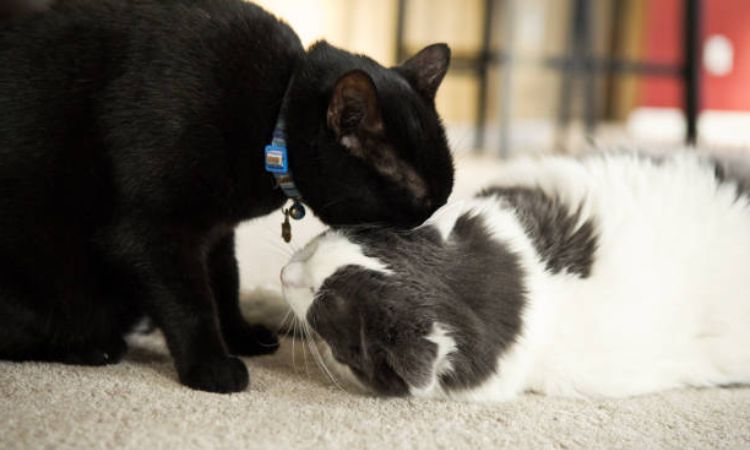
3. Post-Mating Behavior and Care
After mating, it’s important to monitor the queen and provide appropriate care:
- Give her space and privacy; avoid touching or handling her during the after-reaction.
- Ensure she has access to food, water, and a comfortable resting area.
- Observe her for signs of stress or injury, although mild vocalization or movement is normal.
Confirming a Successful Mating
Pregnancy can be confirmed through:
- Palpation: Around day 16, the uterus may feel like a string of pearls; fetuses are easier to feel after day 20.
- Ultrasound: Can detect pregnancy and fetal development from day 26 onward.
- Early signs of pregnancy may include enlarged or pink mammary glands as early as day 18.
Proper post-mating care and monitoring ensure that the queen remains healthy and stress-free, increasing the likelihood of a successful pregnancy and healthy kittens.
Cat Pregnancy: What to Expect
Understanding your cat’s pregnancy is crucial for ensuring the health of both the queen (female cat) and her kittens. From early signs to preparing for birth, this guide will walk you through everything you need to know for a safe and successful pregnancy.
Signs of Pregnancy in Cats
Physical Changes
- “Pinking up” of nipples: Around 16–20 days into pregnancy, a cat’s nipples become pinker, slightly enlarged, and more prominent. This is often the earliest physical sign.
- Weight gain and belly enlargement: By the last 20 days of pregnancy, the queen’s abdomen expands noticeably as kittens grow. Mammary glands enlarge to prepare for nursing.
- Other changes: Some cats may have slightly looser skin or a softer coat during pregnancy.
Behavioral Changes
- Increased affection or docility: Pregnant queens often become calmer, more affectionate, or unusually cuddly.
- Nesting instincts: As delivery approaches, cats may search for a quiet, secluded area to give birth. They often scratch, paw, and groom their belly and genital area in preparation.
- Changes in appetite and activity: Queens may eat more frequently or, in the last day before labor, stop eating completely. Some become restless or hide more than usual.
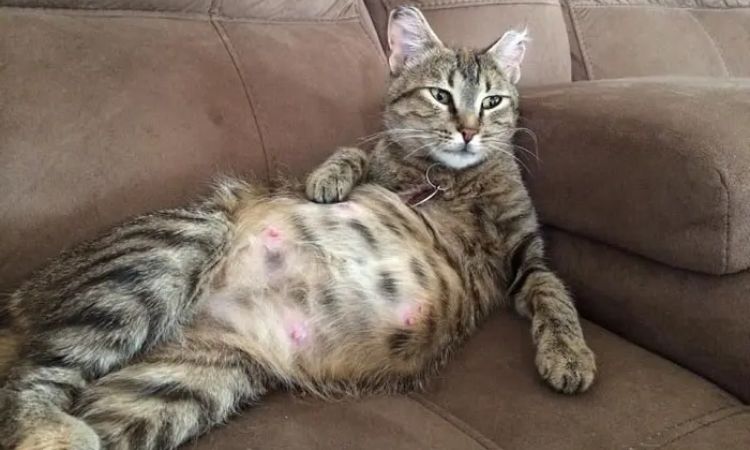
The Feline Gestation Period (Timeline)
Cats are pregnant for approximately 63–65 days (~9 weeks), which can be divided into three trimesters of about 20 days each:
First Trimester (Days 1–21)
- Very subtle changes; pregnancy may not be obvious to owners.
- Slight increase in appetite and occasional morning sickness in some cats.
- Early nipple changes (“pinking up”) become noticeable.
Second Trimester (Days 21–42)
- Belly gradually enlarges as kittens develop.
- Behavioral changes become more apparent: queens often become calmer, more affectionate, and less active.
- Appetite increases to support growing kittens.
Third Trimester (Days 42–63)
- Abdomen is noticeably swollen; mammary glands are enlarged and may produce milk.
- Strong nesting instincts: queen searches for quiet, private areas.
- Frequent, smaller meals are recommended due to reduced stomach space.
- Grooming of belly and genital area becomes more frequent in preparation for birth.
Key Fetal Development Milestones
- 2.5 weeks: Veterinarian can palpate (feel) fetuses.
- 3–4 weeks: Fetal heartbeats visible via ultrasound.
- 6 weeks: X-rays can reveal fetal skeletons, useful for counting kittens.
Veterinary Care During Pregnancy
Routine Vet Visits
- Early confirmation of pregnancy and overall health check.
- Monitor for subtle signs of illness: vomiting, diarrhea, lethargy, or vaginal discharge.
- Rule out pseudopregnancy, where cats show pregnancy signs without carrying kittens.
Nutritional Needs
- High-calorie diet essential for fetal development and maternal health.
- Use a commercial cat food formulated for pregnancy/lactation or for kittens.
- Feed multiple small meals daily; water should always be available.
- Continue this diet until kittens are weaned.
Vaccinations and Parasite Prevention
- Ideally, vaccinate before pregnancy.
- Live vaccines are not safe during pregnancy; killed vaccines may be given under veterinary guidance.
- Parasite prevention (flea/tick and deworming) can continue using pregnancy-safe products.
- A fecal check is recommended to identify worms that can be transmitted to kittens.
Preparing for the Birth (Queening)
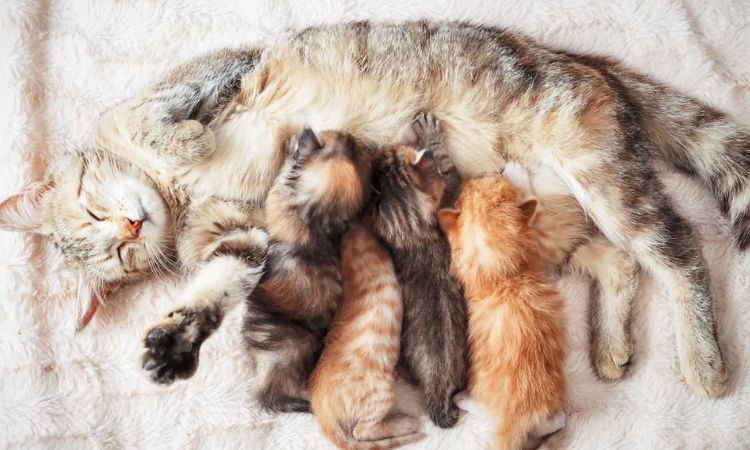
Birthing Kit Essentials
- Clean towels and soft cloths to dry kittens if needed.
- Heating pad or warm blankets (maintain 85–90°F / 29–32°C) for newborns.
- Sterilized scissors for umbilical cords, if necessary.
- Disposable gloves, mild antiseptic, and emergency vet contact information.
Creating a Nesting Area
- Quiet, private, and draft-free location in the home.
- Cardboard box or covered cat bed lined with soft blankets, towels, or sheets. Avoid loose strings or fabrics that could be swallowed.
- Ensure the area allows discreet observation of the queen and kittens.
- Monitor for early labor signs: restlessness, scratching, nesting, and decreased appetite.
Stages of Labor
- First stage: Mild, barely visible contractions; queen may appear restless, vocal, or scratch at nesting area.
- Second stage: Active contractions; kittens pass through the birth canal. Delivery of each kitten typically takes 5–30 minutes.
- Third stage: Expulsion of placenta; usually one per kitten. Queens may eat the placenta, which is normal.
- Some cats may pause between kittens for up to 24–36 hours if they feel unsafe.
- Call a veterinarian if contractions exceed 20 minutes without kitten delivery or if visible distress occurs.
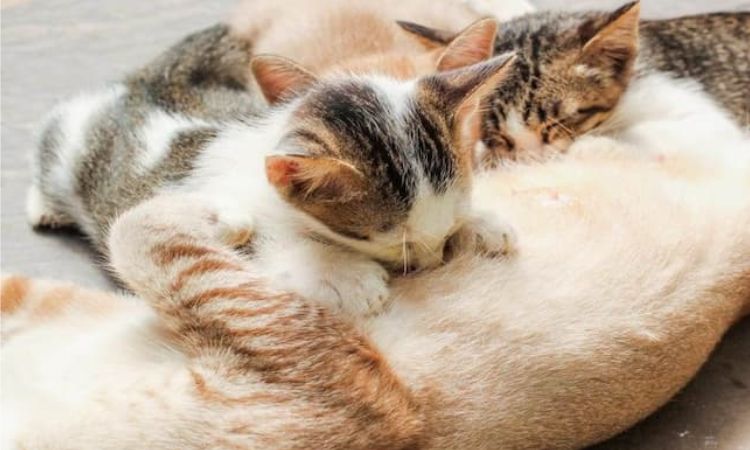
Postpartum Care
- Ensure kittens are dry, and airways are clear.
- Keep nesting area clean and warm (85–90°F / 29–32°C for the first week).
- Monitor nursing and maternal behavior.
- Seek veterinary advice if the queen rejects kittens, has excessive bleeding, or shows signs of illness.
Understanding cat mating and pregnancy is essential for anyone considering breeding. By approaching the process responsibly—prioritizing health, genetics, and proper care—you can help ensure the well-being of both the queen and her kittens. Thoughtful planning and veterinary guidance make all the difference in raising healthy, happy cats while preventing unwanted litters.






